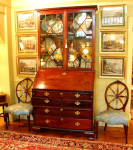Vocabulary of the Antique Trade – Georgian on my Mind
By Hannah Crouthamel on Jun 14 in About Antiques
Georgian. What does the word mean when used to describe furniture in the English antique trade? Georgian is one of a number of adjectives employed to describe a timeframe or era in the history of England. Generally speaking most antique experts, including antique dealers, define the Georgian era as the period from 1714-1811, roughly coinciding with the reigns of George I (1714-27), George II (1727-60) and George III (1760-1820). In 1811, although George III was still alive, he was declared unfit to rule. His son the Prince of Wales as the Prince Regent took over and ruled by proxy until George III died in 1820. So 1811 for our purposes marked the end of the Georgian period and ushered in the Regency period (more on that in a later blog).
Georgian is not one particular design, but instead describes an era which is known for seminal designs and designers. It was an age of huge dynamism and creativity in the arts. Furniture design in particular was inspired by the publication of catalogs which chronicled the changing fashions of the age, especially Thomas Chippendale’s The Gentleman and Cabinet-Maker’s Director, published in 1754; George Hepplewhite’s The Cabinet-Maker and Upholsterer’s Guide, published in 1788; and Thomas Sheraton’s The Cabinet-Maker and Upholsterer’s Drawing-Book; published in 1793.
The general trend of design in the Georgian era can be viewed as a transformation from visually heavier furniture to increasingly more delicate; an era which explored and developed techniques of carving which lightened previously heavy renditions of form.
It was an era which developed ever more delicate furniture, enriched with inlays, new shapes and adornments, all trending towards less powerful and more graceful furniture. Thomas Chippendale, George Hepplewhite, and Thomas Sheraton played prominent roles in this transformation of style. I shall be exploring their contributions to design in my next blogs. Stay tuned!

